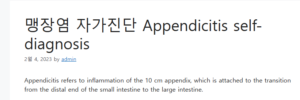Appendicitis refers to inflammation of the 10 cm appendix, which is attached to the transition from the distal end of the small intestine to the large intestine.
Most often cause acute abdominal pain requiring surgical excision (acute appendicitis). Occasionally, symptoms recur, which is called recurrent appendicitis.
Let’s look at 6 ways to check the pain of early symptoms of appendicitis, symptoms before appendicitis, how to self-diagnose, and initial treatment.
In addition to the early symptoms of appendicitis, it would be helpful to refer to the early symptoms of male cystitis.
Popular articles with early symptoms of other diseases

Six self-diagnosis methods for early symptoms of liver cancer, progression rate, and survival rate
6 early symptoms of laryngitis, causes of foreign body sensation, treatment period, and 5 health information 맹장염 자가진단
Table of Contents
6 ways to check the pain in the early symptoms of appendicitis 좋은뉴스
typhlitis
If the appendix is inflamed, pain occurs in the lower abdomen when the stomach is pushed up from the bottom to the top while lying on the stomach.
In addition to abdominal pain, frequent farts and watery diarrhea appear.
There may be symptoms of abdominal pain, pelvic pain, vomiting and fever.
▶ Other early symptoms of appendicitis can be found at the link below.
Appendicitis early symptom pain identification method
Appendicitis early symptom pain check method ▶Click
Appendicitis early symptom pain check method ▶Click
Symptoms before an appendix ruptures
typhlitis
1. Unbearable abdominal pain
Abdominal pain is a representative symptom of appendicitis, and more than 95% of patients visit the hospital with severe abdominal pain. In the beginning, you feel light pain from around the navel, but gradually descend to the right lower abdomen and feel unbearable pain.
2. High fever of 39 degrees or higher
When the appendix becomes inflamed, the body may experience symptoms such as slight fever, chills, and tremors. At this time, if you have a fever of about 37.8 degrees and abdominal pain, you don’t have to worry much, but if the symptoms have worsened until just before bursting, you will suffer from a high fever of 39 degrees or more.
▶ Other symptoms before appendicitis can be checked at the link below.
Symptoms before appendix rupture ▶Click
Symptoms before appendix rupture ▶Click
How to self-diagnose appendicitis
typhlitis
Acute appendicitis can also be diagnosed through self-diagnosis. If you feel severe pain when you press the right lower abdomen with your hand, suspect acute appendicitis and visit an appendix hospital promptly. If the appendix ruptures, more severe pain may occur and a high fever may occur.
appendicitis causes
Although the exact cause of appendicitis cannot be identified, it is known that it can be caused by the bending of the appendix when immunity and physical strength are reduced at the same time due to repeated binge eating or excessive drinking. Some say that appendicitis is caused by intestinal bacteria, or enteritis, while others say that pharyngitis or pneumonia is the cause of appendicitis.
▶ Other causes of appendicitis can be found at the link below.
Read more about causes of appendicitis
Causes of appendicitis ▶Click
Causes of appendicitis ▶Click
Appendicitis initial treatment
If appendicitis is early or the symptoms are mild, antibiotic treatment is sometimes performed, but in most cases, the appendix is removed by surgical treatment. Antibiotics are given before and after surgery to reduce the risk of bacterial infection.
appendicitis treatment
Appendicitis is not preventable, and if surgery is not performed within 3 days of the onset of symptoms, the chance of the appendix bursting is very high. Therefore, when appendicitis is suspected due to mild initial symptoms such as abdominal distension and a feeling of indigestion, it is recommended to visit a hospital for an accurate diagnosis and to undergo surgery as soon as possible.
Recently, appendicitis surgery uses a laparoscopic method rather than an abdominal incision method in which an incision is made in the lower abdomen to remove the appendix. Laparoscopic surgery is a surgical method that is performed by inserting a video camera and various instruments into a small hole in the size of 0.5 to 1.5 cm in the abdomen, also called ‘minimally invasive surgery’.
▶ Appendicitis treatment can be seen in detail at the link below.
Appendicitis Treatment
Read more about appendicitis treatment ▶Click
Read more about appendicitis treatment ▶Click
How to get gas out after appendicitis surgery
Take short, light walks to promote bowel movement.
Walk around the house for 15 minutes, but only if you feel comfortable with this intensity of activity. Walking promotes movement of the intestinal muscles, which helps relieve constipation and bloating, and promotes gas expulsion. Avoid any physical activity that is more strenuous than walking for at least a few days after surgery.
Perform leg raises to help expel gas.
Lie on your back and place a pillow under your knees. Then, with the knee bent, slowly raise the right leg toward the abdomen and hold for 10 seconds. After 10 seconds, lower your leg and repeat the exercise on your left leg. These leg lifts will contract and expand your abdominal muscles while helping move gas through your digestive system. Repeat this exercise 2-3 times a day until the discomfort goes away.
▶ You can check other ways to get gas out after appendicitis surgery at the link below.